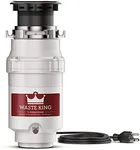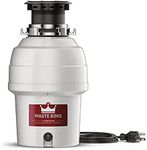Buying Guide for the Best Garbage Disposals
Choosing the right garbage disposal can make your kitchen cleanup much easier and more efficient. The best disposal for you depends on your household size, the types of food waste you generate, and how often you cook. Understanding the key features will help you select a model that fits your needs, is easy to use, and lasts for years.Motor PowerMotor power, measured in horsepower (HP), determines how effectively the disposal can grind up food waste. Lower power (around 1/3 to 1/2 HP) is suitable for small households or light use, handling softer foods and occasional use. Medium power (3/4 HP) is a good fit for most families, managing a wider range of food scraps. Higher power (1 HP or more) is best for large households or frequent cooks who dispose of tougher waste like bones or fibrous vegetables. Consider your cooking habits and the amount of waste you produce to choose the right power level.
Grinding StagesGrinding stages refer to how many times the food waste is broken down before it goes down the drain. Basic models have a single stage, which is fine for soft or small scraps. Two-stage or three-stage disposals grind food more thoroughly, reducing the risk of clogs and handling tougher waste. If you often dispose of fibrous or hard food, or want to minimize plumbing issues, a multi-stage grinder is a smart choice.
Noise LevelNoise level is how loud the disposal is when running. Some models have insulation or special designs to reduce noise, making them quieter. If your kitchen is open to living areas or you’re sensitive to noise, look for models advertised as quiet or with sound-reducing features. For those who don’t mind a bit of noise, standard models may be sufficient.
Feed TypeFeed type describes how you add food waste to the disposal. Continuous feed disposals let you add waste while the unit is running, which is convenient for most users. Batch feed disposals require you to load the chamber and then activate it with a stopper, which is safer, especially in homes with children. Choose the type that matches your comfort with safety and convenience.
Size and InstallationThe size of the disposal affects how much space it takes up under your sink and how much food it can handle at once. Larger units may offer more power and capacity but need more room. Check the space available under your sink and the mounting system to ensure a good fit. If you have limited space or a smaller sink cabinet, look for compact models.
Material and DurabilityThe materials used in the grinding components, such as stainless steel or galvanized steel, affect how long the disposal will last and how well it resists corrosion. Stainless steel parts are more durable and less likely to rust, making them a better choice for frequent use or if you want a long-lasting appliance. For occasional use, less expensive materials may be sufficient.
Ease of MaintenanceSome disposals are designed for easy cleaning and maintenance, with features like removable splash guards or self-cleaning mechanisms. If you want to minimize odors and keep your disposal running smoothly, look for models that are easy to clean and maintain. This is especially important if you use the disposal often or dispose of a variety of food types.














